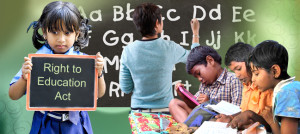This article is written by Pragya Dhoundiyal
Education is one primary area that needs focus, as it is crucial to the development of a country. A higher percentage of educated individuals contribute more towards the economy of the country that in turn leads to blossoming of the nation. Since it is a subject that has multiple dimensions attached to it, some aspects relating to it fall under the Union List whereas the rest under the concurrent list of the Constitution of India. As a result, both the union and the states are empowered to make legislation with respect to it. Education was made a fundamental right by the 86th constitutional amendment which introduced Section 21-A in the Constitution of India. India joined the list of 135 countries that have legislation in place to implement it as a fundamental right, when the Right To Education Act finally came into force in 2010.
Salient features of the Act:
Education has now been made compulsory and free for children in the age bracket of 6 years to 14 years, which is further stretched to 18 years for children with disabilities. ‘Free education’ implies free education for those who have enrolled themselves in the appropriate institutions that are aided by the government, whereas the words ‘compulsory education’ cast an obligation on the appropriate government to ensure that a mechanism is there in place for the enforcement of the provisions. In order to enforce the fundamental right, all the private and government schools are required to reserve at least 25% of their seats for the disadvantaged groups and the weaker sections (section 12(c) of the RTE Act, 2009). The Act separates fraudulent schools, and donations and concessions are not allowed under the law. It also prohibits states from expelling, holding back or even necessitating a child to clear board exams till his or her elementary examinations are not over. Efforts to bring the drop outs, at par with the regular students have also been made by providing them with special training. Other provisions that make the Act attractive, are the steps that are planned to be taken in the direction of infrastructural development, student-teacher ratio and the up gradation of the faculty.
Terminologies:
Section 2(d) of the RTE Act, 2009 defines a child belonging to a disadvantaged group as follows:
“A child belonging to the Scheduled Caste, the Scheduled Tribe, the socially and educationally backward class or such other group having disadvantage owing to social, cultural, economical, geographical, linguistic, gender or such other fact, as may be specified by the appropriate Government, by notification.”
Section 2(e) of the RTE Act, 2009 defines a child belonging to a weaker section as: “A child belonging to such parent or guardian whose annual income is lower than the minimum limit specified by the appropriate Government, by notification.”
Criticism:
The main point of contention was the reservation for the disadvantaged groups and the weaker sections. The Supreme Court put to rest all the speculations to rest when it passed its landmark judgment upholding the constitutional validity of the Act. The case was heard and decided by a three-judge bench of Chief Justice S H Kapadia and justices K S Radhakrishnan and Swantanter Kumar, who said that the act will apply uniformly to government and unaided private schools except unaided private minority schools. The case was decided by the majority with only K S Radhakrishnan presenting a dissenting view. Some people speculate that this might create a rift as the unaided private minority schools are allowed to function without any checks and balances.
In order to justify their stand the bench held that:
“By judicial decisions, right to education has been read into right to life in Article 21. A child who is denied right to access education is not only deprived of his right to live with dignity, he is also deprived of his right to freedom of speech and expression enshrined in Article 19(1) (a). The 2009 Act seeks to remove all those barriers including financial and psychological barriers which a child belonging to the weaker section and disadvantaged group has to face while seeking admission.”
“From the scheme of Article 21A and the 2009 Act, it is clear that the primary obligation is of the State to provide for free and compulsory education to children between the age of 6 and 14 years and, particularly, to children who are likely to be prevented from pursuing and completing the elementary education due to inability to afford fees or charges.”
The judgment did not bring joy to many who still doubt the validity of such reservations as many believe that the sole basis for admission should be merit. Some fanatics even go to the extent of saying audacious things like, ‘they might prove to be a bad influence on the children belonging to the elite class.’ These remarks seem completely baseless and are made by people who harbour a class prejudice.
The case further went in for an appeal before a five-judge constitutional bench, headed by chief justice R M Lodha because of the widespread resentment and disagreement with the ruling. The court again upheld the validity of the RTE Act, 2009 but this time both aided and unaided minority institutions were held to be out of the ambit, stating that minority institutions could not be compelled to admit students who do not belong to the minority section. The bench said, “In our view, if the Act is made applicable to minority schools, aided or unaided, the right of the minorities under Article 30(1) of the Constitution will be abrogated. Therefore, the (provision of the) 2009 Act, which made it applicable to minority schools is unconstitutional.” The private institutions are still under the ambit because the State provides for the reimbursement of the charges incurred by the private institutions on account of admitting and providing free education to the students of the reserved class.
Conclusion:
The Act provides a bulk of incentives to the underprivileged groups, that results in unequal treatment of the children but like the Centre had emphasized there is a need to delink merit and talent from social and economic differences among different sections of society and said that the Act calls for “moving towards composite classrooms with children from diverse backgrounds, rather than homogeneous and exclusivist schools.”
In order to uplift the society there should be a level playing field for all. The government should work towards building infrastructure so as to train the underprivileged to have the same expertise and skill so that they can also be a part of the healthy competition. Till the infrastructure is built some incentives will have to be given, but these schemes of carrot and sticks will not stand the test of time. A person belonging to an unreserved category has to put in quadruple effort to get what he aspires whereas the reserved class gets away with a little bit of hard work. The saddest part about reservations is that the people who need to be targeted are still out of the picture, and it is the ‘elite in the disadvantaged groups’ who are reaping the benefits generation after generation. The target group still survives silently in the bushes of the deserted areas, which are still out of bound. So the government will have to come up with some innovative measures to contain the resentment of the masses.
 Serato DJ Crack 2025Serato DJ PRO Crack
Serato DJ Crack 2025Serato DJ PRO Crack











 Allow notifications
Allow notifications



